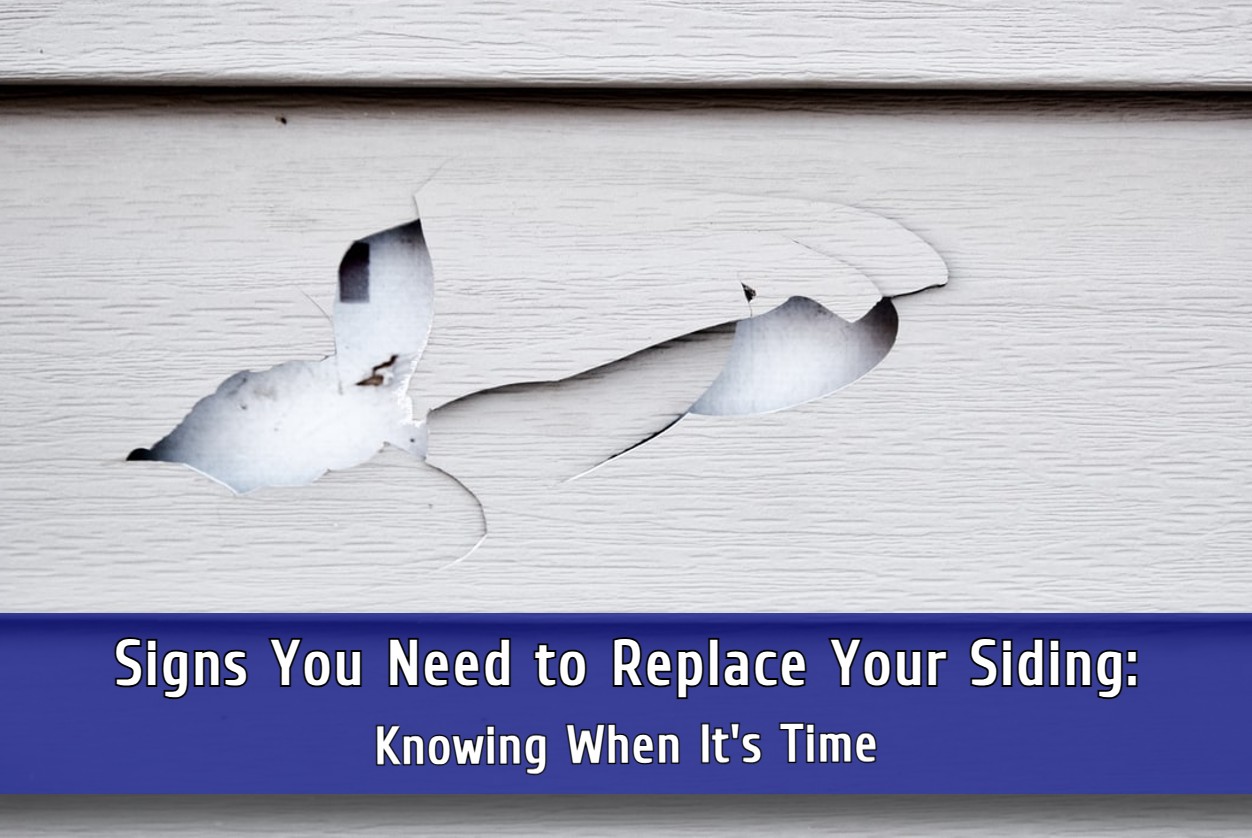Your home’s siding does more than just contribute to its curb appeal, it plays a critical role in protecting your home from the elements. Over time, exposure to weather and environmental factors can wear down your siding, potentially compromising your home’s structural integrity and energy efficiency. Recognizing the signs that you need to replace your siding is essential for maintaining the safety and aesthetics of your property.
Signs of siding damage, such as cracks, warps, or even mold, are clear indicators that your siding may require attention. Furthermore, understanding the best siding materials for homes and knowing how often to replace siding can significantly enhance your home’s resilience and value.
Whether you’re noticing the first signs of wear or are planning for future upgrades, this guide will provide you with essential siding replacement tips and help you identify the key signs to replace house siding. By staying informed, you can ensure your home remains secure and beautiful for years to come.
Visible Wear and Tear: Top Signs of Siding Damage
When it comes to maintaining the integrity of your home, spotting the early signs of siding damage is crucial. Cracks, warps, and rot are not just unsightly, they are clear indicators that your siding is failing and may need replacement. These visible signs of distress can lead to more significant issues if not addressed promptly.
Cracks in the siding allow moisture and pests to infiltrate the home, potentially leading to structural damage and decreased energy efficiency. Warping may indicate poor installation or exposure to excessive heat, while rot is a common problem in wood siding that has been exposed to moisture for prolonged periods. These issues, if ignored, can escalate into costly repairs and might compromise the structural integrity of your home.
It’s essential to act swiftly when these signs of siding damage appear. Replacing damaged siding not only enhances the appearance of your home but also reinstates its protective barrier against the elements. Opting for the best siding materials for homes and adhering to recommended timelines on how often to replace siding can significantly prolong the lifespan of your home’s exterior. With these siding replacement tips in mind, homeowners can ensure their property remains both functional and visually appealing.
Increased Energy Bills: A Hidden Sign of Siding Failure
Compromised siding can significantly impact your home’s energy efficiency, leading to increased heating and cooling costs. When siding fails, it often leads to poor insulation, allowing heat to escape during the winter and cool air to leak out in the summer. This inefficiency forces your HVAC system to work harder, which not only increases your energy bills but also wears down your system more quickly.
To monitor for such inefficiencies, homeowners should keep a close eye on their energy bills. A sudden spike in costs, especially if they do not correlate to a known increase in energy rates or changes in home usage, might indicate that your siding is no longer performing effectively. Periodic inspections of your siding for any signs of damage, coupled with a review of monthly energy costs, can help identify issues before they lead to more significant financial burdens.
For those living in Central Ohio, where temperatures can vary greatly throughout the year, maintaining the integrity of your siding is crucial for keeping energy costs down. Regular maintenance checks, understanding the signs of siding damage, and knowing when it’s time for a siding replacement can help protect your home from excessive energy waste. Remember, investing in high-quality siding materials and adhering to professional siding replacement tips can offer long-term savings on your energy bills.
Water Damage and Mold: Symptoms of Siding Issues
Water damage and mold growth are critical symptoms indicating your siding may no longer be effective. These issues often arise when siding allows moisture to infiltrate, creating a perfect environment for mold to thrive. If you notice mold or excessive moisture around your siding, it’s a clear sign that it needs inspection and possibly replacement.
When you detect these signs, taking immediate action is crucial to prevent further damage to your home. Start by assessing the extent of the water infiltration and identifying any visible signs of mold on or near the siding. It’s important to address these issues quickly as prolonged exposure to moisture can deteriorate your siding further and potentially affect the structural integrity of your home.
If your siding is compromised, consulting with a professional for a comprehensive assessment and considering the best siding materials for homes can make a significant difference. Frequent checks and maintenance can extend your siding’s lifespan, but knowing how often to replace siding based on its current condition and the materials used is key to ensuring your home remains protected.
Best Siding Materials for Homes
When it comes to siding replacement, selecting the right material is crucial for both durability and aesthetic appeal. In Central Ohio, where weather conditions can vary dramatically, the material you choose for your home’s siding needs to withstand harsh elements while complementing your home’s style. Among the popular choices are vinyl, wood, and fiber cement, each offering unique benefits and challenges.
Vinyl siding is favored for its cost-effectiveness and low maintenance. It resists moisture and fading, making it a practical choice for many homeowners. However, it can crack in extremely cold weather and may warp under high temperatures. Wood siding offers a classic look and can be very durable if properly maintained, but it requires regular painting or staining to resist weathering and decay. Fiber cement siding, while more expensive, provides a great balance of durability, weather resistance, and aesthetic versatility, making it a popular choice among homeowners looking for long-term solutions.
When selecting the best siding materials for your home, consider factors such as the local climate, your home’s architectural style, and long-term maintenance requirements. Consulting with a professional can provide insights into what materials best suit your needs.
Life Expectancy of Siding: When to Plan for Replacement
Understanding the lifespan of various siding materials is crucial for maintaining the functionality and aesthetics of your home. Different materials can vastly differ in durability and longevity. For instance, vinyl siding can last between 20 to 40 years, while fiber cement siding may last over 50 years if maintained properly. The lifespan of wood siding varies significantly based on the type of wood and the level of maintenance but typically ranges from 15 to 40 years.
To effectively plan for siding replacement, it’s important to assess the age of your current siding. Start by checking home improvement records or contacting previous homeowners for installation dates. Regular inspections can help identify early signs of siding damage, such as cracks or warping, which are indicators that your siding may need to be replaced sooner than anticipated. Planning ahead for such replacements can avoid unexpected costs and ensure your home remains protected and visually appealing.
By staying informed about the best siding materials and recognizing the signs to replace house siding, you can make well-timed decisions that enhance your home’s value and curb appeal. Keep these siding replacement tips in mind to maintain the integrity and efficiency of your home’s exterior.
DIY vs. Professional Replacement: Siding Replacement Tips
Deciding whether to hire a professional or undertake a siding replacement project yourself can be challenging. While DIY projects can be cost-effective and rewarding, certain scenarios definitely call for professional expertise. Recognizing when a professional is needed is crucial to ensure the job is done safely and effectively.
If you notice extensive damage, such as large areas of rot or widespread mold, consulting a professional is advisable. These issues often require comprehensive solutions that go beyond superficial repairs. For those in Central Ohio, professional roofing contractors are familiar with local climate conditions and can provide tailored advice and services.
For homeowners considering a DIY siding project, it’s important to assess your own skills and the scope of the project. Small repairs or replacing a few panels might be manageable on your own. However, a complete siding replacement often involves challenges like precise cutting and fitting, which might require specialized tools and skills. Before starting, research the best siding materials for homes and gather all necessary tools and safety equipment.
Additionally, understanding how often to replace siding and recognizing signs of siding damage can help in planning and executing your project effectively. If opting for a DIY approach, ensure you follow detailed guides and adhere to safety standards to avoid any potential issues.
Ready to Upgrade Your Siding?
Get in touch with AM Roofing & Siding today for expert siding replacement services. Don’t let worn-out siding compromise your home’s protection and energy efficiency. Call us at (740) 974-8268 to schedule a consultation and take the first step toward enhancing your home’s curb appeal and durability.

